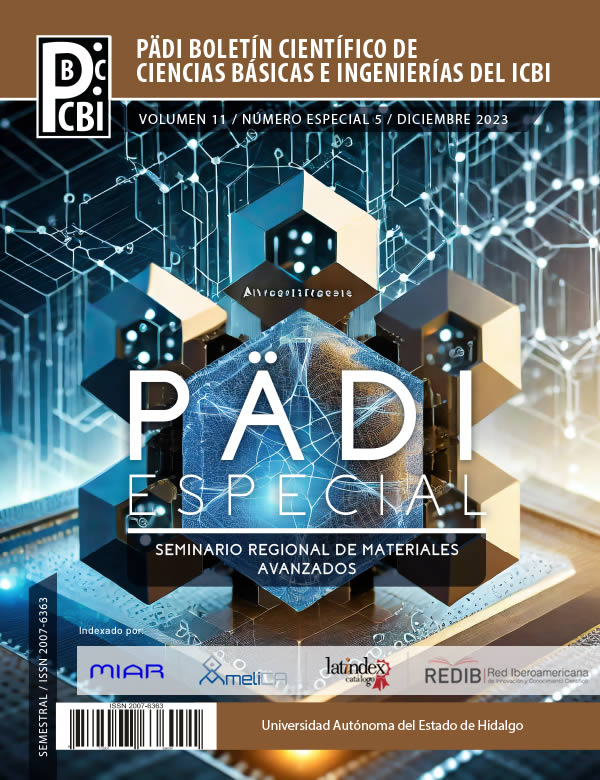Effect of Fe3+ doping in Bi0.5Na0.5TiO3 sintered at low temperature
Abstract
Piezoelectric ceramics of composition Pb[TixZr1-x]O3 (PZT) are widely used because of their excellent properties. However, they are highly polluting, due to their lead content. In this work, the dielectric properties of lead-free piezoelectric potential Bi0.5Na0.5TiO3 (BNT) doped with different Fe3+ contents, sintered at low temperature, are analyzed. The synthesis and processing was carried out by high-energy mechanical milling and subsequent sintering at 900 °C. X-ray diffraction results confirm the BNT synthesis with rhombohedral crystal structure for the whole range of Fe3+ substitution. Additionally, the relative permittivity of the doped samples were found to be in the range of 400 to 500 showed higher stability over the whole frequency range, compared to the undoped BNT, without observing a clear trend as a function of Fe3+ content. The dielectric losses and electrical conductivity reveal the obtaining of materials with potential for piezoelectric materials at low frequencies.
Downloads
References
Aksel, E., Erdem, E., Jakes, P., Jones, J. L., Eichel, R. A. (2010). Defect structure and materials “hardening” in Fe2O3 -doped [Bi0.5 Na0.5] TiO3 ferroelectrics. Applied Physics Letters, 97(1).
DOI: https://doi.org/10.1063/1.3455888
Castro Noguera, O. (2018). Diseño de un dispositivo nanoelectromecánico para la recolección de energía.[tesis] Universidad veracruzana.
Chen, H. D., Udayakumar, K. R., Cross, L. E., Bernstein, J. J., & Niles, L. C. (1995). Dielectric, ferroelectric, and piezoelectric properties of lead zirconate titanate thick films on silicon substrates. Journal of Applied Physics, 77(7), 3349–3353.
DOI: https://doi.org/10.1063/1.358621
Dunce, M., Birks, E., Antonova, M., Bikse, L., Dutkevica, S., Freimanis, O., Livins, M., Eglite, L., Smits, K., & Sternberg, A. (2021). Influence of sintering temperature on microstructure of Na0.5Bi0.5TiO3 ceramics. Journal of Alloys and Compounds, 884.
DOI: https://doi.org/10.1016/j.jallcom.2021.160955
Grupo Kistler. (2023). Efecto piezoeléctrico. https://www.kistler.com/INT/es/efecto-piezoelectrico/C00000136
Halim, N. A., Velayutham, T. S., & Abd. Majid, W. H. (2016). Pyroelectric, ferroelectric, piezoelectric and dielectric properties of Na0.5Bi0.5TiO3 ceramic prepared by sol-gel method. Ceramics International, 42(14), 15664–15670.
DOI: https://doi.org/10.1016/j.ceramint.2016.07.022
Mahapatra, S. Das, Mohapatra, P. C., Aria, A. I., Christie, G., Mishra, Y. K., Hofmann, S., & Thakur, V. K. (2021). Piezoelectric Materials for Energy Harvesting and Sensing Applications: Roadmap for Future Smart Materials. Advanced Science, 8(17).
DOI: https://doi.org/10.1002/advs.202100864
Muhammed, K. R., Scrimshire, A., Sterianou, I., Bell, A. M. T., & Bingham, P. A. (2020). Physical properties and sinterability of pure and iron-doped bismuth sodium titanate ceramics. Journal of the Australian Ceramic Society, 56(4), 1441–1449.
DOI: https://doi.org/10.1007/s41779-020-00461-5
Rodríguez Rey, A., Cuéllar Luna, L., Maldonado Cantillo, G., & Suardiaz Espinosa, M. E. (2016). Efectos nocivos del plomo para la salud del hombre. Revista Cubana de Investigaciones Biomédicas, 35(3), 251–271. http://scielo.sld.cu
Schmitt, V. (2013). Effect of dopants on the local atomic structure and sintering behavior of Bismuth Sodium Titanate [Doctoral Thesis]. University of Bayreuth.
Watcharapasorn, A., Jiansirisomboon, S., & Tunkasiri, T. (2007). Sintering of Fe-doped Bi0.5Na0.5TiO3 at < 1000 °C. Materials Letters, 61(14–15), 2986–2989.
Copyright (c) 2023 Luis Alberto Esquivel Arias, Ana María Bolarín Miró, Félix Sánchez de Jesús, Claudia Alicia Cortes Escobedo, Luis Gerardo Betancourt Cantera

This work is licensed under a Creative Commons Attribution-NonCommercial-NoDerivatives 4.0 International License.













